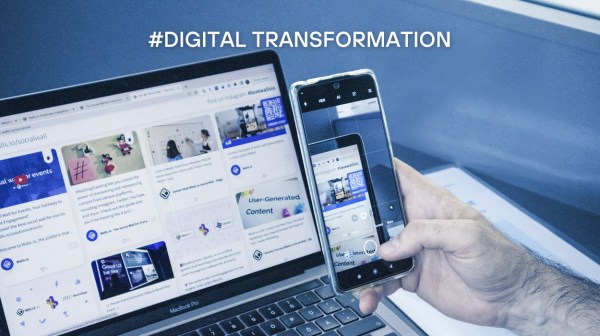Digitalisation has arrived to make our daily lives easier, both personally and in the business world, forcing companies to undergo a digital transformation, a process that consists of reorienting a company towards the application and use of emerging technologies.
We should not think that digital transformation is a new process, but it has accelerated in recent years thanks to the digital revolution we are experiencing, which is forcing companies to make a radical change in order to survive.
What must be clear is that digital transformation is no longer an option. A company cannot consider whether or not to opt for this change, as there is no other way to renew itself and compete with others.
Cultural and technological change
It is not simply a matter of acquiring state-of-the-art technology, but a cultural as well as a technological change, as it involves organisations making fundamental changes in the way they work, as well as in the way they relate to customers.
Google Cloud defines digital transformation as the process of using modern digital technologies, including all types of hybrid, public and private cloud platforms, to create or modify business processes, culture and customer experiences to address changing business and market dynamics.
One of the many virtues of digital transformation is that it is conceived as a continuous adaptation to a constantly changing environment. It can therefore be said that its objective is to have a continuously evolving technical and operational base that can respond to customer expectations and changing market conditions.
Elements for a digital transformation
Any digital transformation within an organisation must include a number of elements, as a way to evolve and understand the new digital culture, among which we can mention:
- Comprehensive training plan, including all the necessary tools for the employee to take on this change.
- Reorganisation of the work structure. The organisational structure of the company needs to respond to the new and different digital way of working, including new roles and positions.
- Specific training plan, whereby employees have access to the necessary training to handle the new environment.
- Incorporation of new professional profiles, more in line with the new needs of digital work.
Benefits of digital transformation
There are many benefits of digital transformation within a company. Among them, Google Cloud highlights infrastructure modernisation, better data management, statistics, avoids isolated environments, detects problems quickly and provides solutions, and saves costs.
For its part, SAP points out that these benefits include more information for planning the company’s strategy, greater efficiency and productivity, an improved customer experience and an innovative boost to the business model.
They also stress that this transformation means greater agility and resilience to disruption, anticipating market changes and opportunities, as well as new ways of connecting and collaborating, and optimising future business growth strategies.
The list of benefits of digital transformation could go on and on, but if there is one thing experts agree on, it is the improvement in productivity and customer experience, which limits human error and helps to reduce costs.
Emerging technologies
The main allies of technological transformation are a series of emerging technologies, which are becoming more and more commonplace in our daily lives, not only in the world of work, but in all areas.
We are talking about Artificial Intelligence, the Internet of Things, robotics, Cloud Computing, Machine Learning, Blockchain or Virtual Reality, to name but a few of the technologies that are helping the digital change in demand.
Digital transformation and Covid-19
The Covid-19 pandemic was key to understanding the need for organisations to address digital transformation. Where the process was more advanced, there was a greater margin of response to resolve and make resources available to reduce the obstacles.
A sign of this change in mindset can be found in the forecast made before the pandemic in October 2019 by industry analyst IDC that global spending on digital transformation would reach $2.3 billion by 2023. However, in December 2020, eight months after the pandemic, IDC nearly tripled that estimate to $6.8 billion.
A survey by the consultancy McKinsey, The new digital edge:Rethinking strategy for the post-pandemic era, to senior business executives, highlights that since the pandemic began, there is a sense of urgency among decision-makers to digitise and modernise their legacy processes and systems.
According to the survey, only 11% of executives believe their current business models will be economically viable in 2023, while another 64% say their companies need to build new digital businesses to help them achieve this.
Spain and digital transformation
Spanish companies and public administrations also continue to advance along the path of digital transformation, a path on which Spain is trying to follow the main powers in our region.
This can be seen in the DESI (Digital Economy and Society Index), which, within the framework of the European Commission, monitors the progress made by EU Member States in terms of digital competitiveness, and which, in its section on the integration of digital technology, indicates that 62% of Spanish SMEs have at least a basic level of digital intensity and 24% have embraced e-commerce.
However, he points out that few companies are taking advantage of technologies such as artificial intelligence, big data or cloud services.
Meanwhile, the study “Use of digital technologies by companies in Spain”, prepared by the National Observatory of Technology and Society, shows how Spanish companies have advanced in the digital transformation of their businesses in 2021.
There is a growing use of emerging technologies such as artificial intelligence, data analytics, cloud computing and the internet of things.
Among the data from this study, companies with artificial intelligence systems increased 1.3 points in the last year, from 7% in 2020 to 8.3% in 2021, while the use of big data analysis also evolved compared to 2020: more than 11% used this type of technology compared to 8% the previous year.
The goal for 2025, according to ONTSI, is that one in four Spanish organisations will have incorporated these technologies into their activity.
In addition, 32% of Spanish companies reported using cloud services in 2021, a growth of 4 percentage points compared to the previous year.
For the internet of things, the technology that interconnects objects and devices through a network, growth has been much more significant, at 11 percentage points, rising from almost 17% in 2020 to around 28% in 2021.
The digital transformation as we know it now has no brakes, and both the public and private sectors must embrace it, with all its implications, if they are to survive in an increasingly digital world.












